The sales team creates a new customer with an equipment sale and the parts team has traditionally been given the task of keeping them by providing support after the sale. Innovative dealers are finding new ways to help the parts counter expand from its role as support center to sales generator.
“Parts are where the profits are and parts have always been the lifeblood of our business. It’s the biggest reason for us to be in the power equipment business,” says Dan Weingartz, owner of Weingartz, a 5-store dealership in Michigan.
Consider new strategies for increasing parts sales, such as by compiling more data to better plan inventory, setting metrics for customer service, investigating online selling — and asking customers for their parts business.
Gathering Data
Aaron Boggs is corporate aftermarket manager for Finch Services, a John Deere dealership with 6 locations in Maryland and Pennsylvania. The dealership, which is celebrating its 70th anniversary, also carries Bobcat, Diamond Mowers, Honda, Mackissic, Toro, Echo and Stihl. Boggs says they analyze parts sales data using reports from the dealership’s PFW business management system and then use those trends for stocking the right parts inventory. (PFW is now a business unit of CDK Global and recently changed its software name to CDK Global Heavy Equipment.)
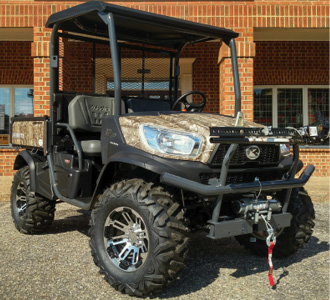
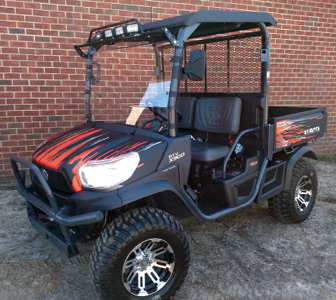
Land & Coates of Virginia has increased parts revenues through add-ons for the Kubota RTVs it sells, such as graphics, rims, winch kits, light kits and more.
Photos Courtesy of Land & Coates
“We have many reports that we pull from our business system to do our projections and a lot of them are customized. We pull reports daily, monthly and quarterly. We also look at things like ‘first pass fill’ and ‘overall fill.’ First pass fill reports look at how often we have certain parts in stock. These are parts we’ve identified that should be in stock 100% of the time. Overall fill is how often we have the parts in stock that customers might request. Our goal is 85%, so 85 times out of 100, I want to have the requested part in stock. If that measurement is above 85%, I’m probably overstocked,” Boggs says. He bases that percentage on discussions with other dealers in his “John Deere 20 Group,” a networking group led by Currie Management Consultants.
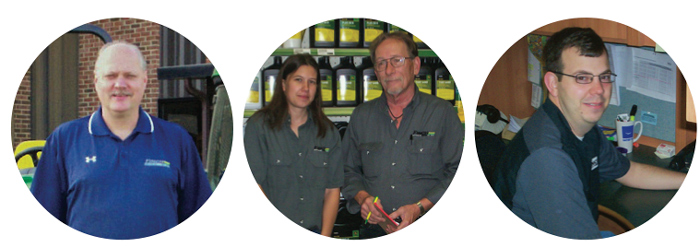
Aaron Boggs (left) is corporate aftermarket manager for Finch Services, which has locations in Maryland and Pennsylvania. His team includes parts managers Laura Bowman, Jon Seymour, who has worked at the dealership for 41 years, and Paul Judge (right), who handles analysis of corporate inventory.
Photos Courtesy of Finch Services
Boggs’ team includes customer service representatives (CSRs) who work in the field along with local parts staffs at each of the dealerships’s locations. “The CSRs are where we find we get the most bang for our buck because they’re in front of the customer and see them on a monthly basis. Sometimes timing is everything, as well as getting to know their businesses. Persistence is our mantra,” he says.
Boggs says a challenge they face in the parts department is the varying tractor configurations. It’s no longer a matter of stocking parts based on one tractor. Now, he has to look at the configurations for that model and how many of those configurations they have sold. He relies on the CSRs to help monitor those details.
The dealership emphasizes training for better customer service and to uncover new sales opportunities. “We do a ‘show me’ test for all of our positions. We give them a scenario and see how they handle it. Our parts people will work with technicians in the shop to get some of the training they need,” Boggs says. “Manufacturers are really good at sales training and technician training, but parts training needs to be improved.”
“Having parts in stock is the most important thing in the parts business...”
Part of that preparation includes discussing upselling opportunities. “We’re training staff to make recommendations regarding related parts. So, if the customer buys a water pump, we ask about gaskets and seals. It’s more than just upselling; it’s ensuring they walk away with what they need. A lot of times they don’t know what other parts they might need,” he says.
Boggs says they do have an online aspect to their parts department, but says it only offers basic functionality, such as parts lookup, the ability to check store availability and online purchases of basic parts. “We don’t have the manpower to do it right. We just haven’t invested the resources because the sales have never justified it,” he says.
In terms of opportunities, Boggs says, “We stay the course with the basics and go back to the fundamentals of delivering great customer service. We send out parts and service surveys through Satisfyd and monitor them closely. That’s what we focus on — asking the customer what they need, where we’re failing and where we’re succeeding.”
Satisfyd assists companies with customer retention through survey and reporting software.
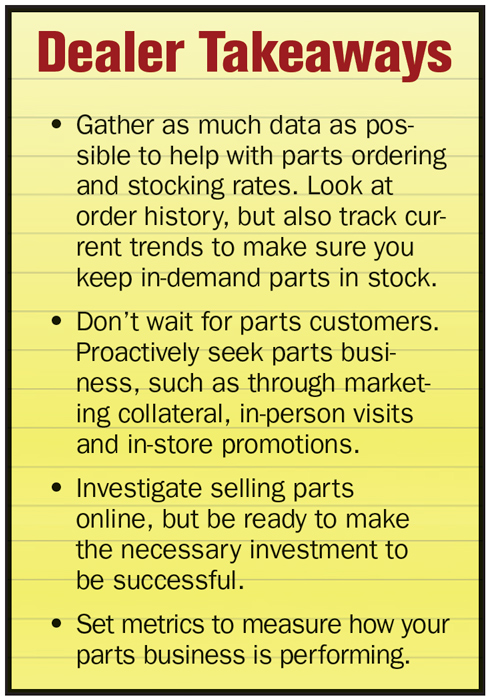
Leveraging Delivery, Promotions
David Brant is vice president of parts for Heritage Tractor, a John Deere dealership with 9 locations in Kansas and Missouri. The dealership also carries Polaris, Stihl, Honda Power Equipment and other brands. (Heritage Tractor was featured in Rural Lifestyle Dealer’s 2013 Season-to-Season series.) Brant has management duties, such as forecasting and ordering through its John Deere Equip system, but he also regularly visits the stores. “I visit stores monthly where I go through my 10 points checklist. I check whether the showroom displays are clean, stocked and priced and whether monthly specials are displayed properly. I also track housekeeping details, such as how many open tickets we have, how many parts are on hand with no bins — tracking negative quantities.”
Brant also manages the dealership’s parts delivery route, which helps him leverage their 9 locations’ inventory to sell more parts. The delivery vans each pull a trailer to move smaller equipment between the stores, such as mowers. “This is one of the bigger benefits of multiple locations. A lot depends on where the route is, but there is a good chance that a store could have a part delivered the same day,” he says.
A marketing tool that Heritage has been using for several years is its wall calendar, which features customer submitted photos. Each month also features a promotion or discount. For instance, they might offer 12% off filters or 10% off oil. They also offer discounts on toys and merchandise as well as products like home maintenance kits and outdoor power equipment, which are all handled by the parts department. They promote sales in the store with TV screens behind the parts counter.
Heritage has online parts functionality through John Deere, but Brant says customers mostly use the site to research parts and check availability. “Ninety-five percent of the people are using it to see if we have a part, to check the pricing or to find the part number,” he says.
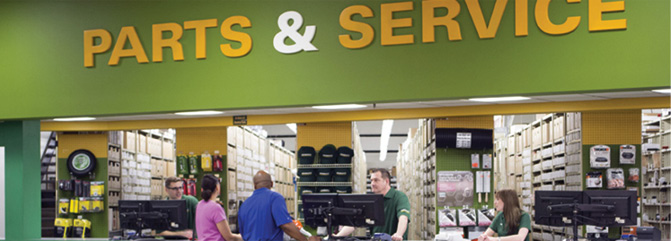
In-store and online parts sales are a significant revenue source for Weingartz, which has 5 locations in Michigan. The parts team at the Farmington Hills, Mich., location includes (from left) Jeremy Krefman, Michael Maurer and Jami Rathka.
Photo Courtesy of Weingartz
Brant says a challenge is the slowdown in new equipment purchases in the large ag market segment. “A lot of people think that when ag sales decline parts and service revenues will increase, but that is not 100% true. It depends on the age of the equipment. Many of the machines customers are holding onto are still new, maybe a year old, so they are still in warranty and breakdowns are less likely,” Brant says.
He says there could be opportunities on the ag and rural lifestyle side to capture attachment sales for previously purchased tractors, which would be considered parts revenue. Brant says the parts and sales teams work together. “It’s a ‘hand-in-hand’ deal. We don’t have it in the job description where we say the salespeople have to promote parts, but our sales guys know that it’s all connected and vice versa,” he says.
Brant says having the parts in stock and suggestive selling are the best ways to increase parts sales. “Having a good parts inventory leads to a comfort level for a customer in terms of buying more equipment and knowing we’ll have the parts,” he says. “With suggestive selling, we’re trying to fulfill customer needs the first time so they can complete their repair instead of them having to make multiple trips.”
Promoting Accessories
Nick Goodrich is a salesperson with Land & Coates, which has 7 locations in Virginia and is celebrating its 70th year. The dealership carries Kubota, Hustler, Toro, Echo, Shindaiwa and other brands. Goodrich says parts sales offer good opportunities for growth. “It’s absolutely something that we are always looking for ways to improve. Our outside sales team is always checking in with municipalities, golf courses, landscapers and farms and 90% of our visits generate parts sales. I’ll call to let them know I’m coming and I’ll deliver parts right to their door,” he says.
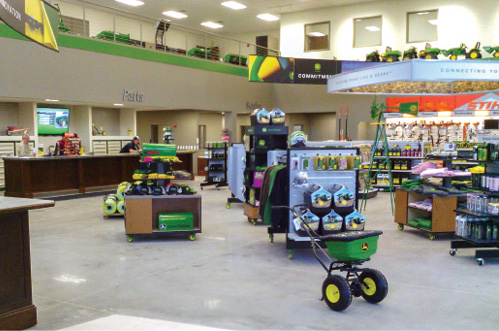
Heritage Tractor’s parts strategies include monthly checks of its 9 locations in Kansas and Missouri to make sure monthly specials are displayed properly and displays are clean as well as stocked and priced correctly.
Photo Courtesy of Heritage Tractor
Goodrich and the team have greatly increased parts revenues this year with accessory add-ons for Kubota RTVs. He saw an RTV outfitted at a dealer meeting last year and worked with Matt Wiedmann of Orange Aftermarket, a company that sells accessories for Kubota equipment.
“You can see accessories in a catalog, but they just don’t do them justice. The customer needs to see it in person. I spent some time last winter outfitting a unit with custom graphics, rims, lights and a few other items,” he says.
Goodrich says the unit generated interest in sales as customers saw the options that are available. “Everybody wants their RTV to stand out or fit their specific needs. A customer came in, saw the RTV we outfitted and said, ‘I’ve got to have it,’ and bought the display unit right off the floor. We took the time to build it and it was a home run,” he says.
The accessories can often be included in the financing for the vehicles, which encourages more sales.
Maintaining Inventory
Dan Weingartz, owner of Weingartz, says his dealership’s success in generating parts revenues is based on inventory, trained experts and online sales. Weingartz carries Exmark, John Deere, Cub Cadet, Kubota, Honda, Toro, Stihl and Redmax.
“Our motto is ‘selection.’ Expertise and selection is what we sell,” Weingartz says. “We’re known as ‘the place that has it.’ That’s been the biggest thing for us and there’s always the opportunity to grow with that reputation. Having parts in stock is the most important thing in the parts business.”
Weingartz uses software from Infor (SX.enterprise) to track its inventory and collect data about parts that are or aren’t selling. “We’re very data driven. We’ve made a lot of investments in our computer system. This gives us the ability to track parts and data across multiple locations.
“Gathering data allows us to stock a part that’s selling well at all our stores, or we can move parts that aren’t selling well to different locations. That eliminates the concern about losing out on demand and allows us to be more liberal in our parts orders.
“If we sell something twice or more in a year, we are going to stock it all of the time. We carry more parts than the formulas say we should, but we also stay on top of returning parts that aren’t moving,” Weingartz says.
The dealership also has a centralized call center to answer questions. “It’s a group of people who do nothing but answer phones, but it’s staffed with people who have worked our parts counters. They are true customer service experts,” he says. “We’ve set a company target that 90% of callers won’t wait on hold for more than 60 seconds.”
Selling Online
Weingartz has been selling parts online for about 6 years, with solid gains in sales being made in the last 3 years. “Online sales are a significant piece of our business. It’s taken a long time to grow and it’s been an incredible learning experience. Having a parts business online is more expensive than selling just in stores, but the opportunities are outstanding. The shocking part is the amount you have to pay in advertising and fulfillment. I thought it was going to be easy money, but it’s been anything but that,” he says.
The dealership uses a third-party e-commerce system that connects to its business system and they’ll implement a new site this summer. Weingartz says they’ve taken thousands of photos and developed their own content to promote sales.
The opportunities might be great, but so is the competition. “It’s a crowded space and the competition is very good at it. You have to be progressive, customer focused and invest in inventory. It’s much tougher than selling parts in our store, but the opportunity is huge. We only feel like we’ve touched the surface of the market,” he says.
Manufacturers selling parts online are also a concern. “It’s a lot easier for them to get clicks and it could become a bigger problem for dealers as we go forward,” Weingartz says.
Recommending Original Parts
Many dealers say they recommend parts from manufacturers before aftermarket parts. “We carry a few non-OEM parts, but not much, maybe some automotive type parts from NAPA. We try to stay with OEM, with quality being the main reason,” says Wayne Wittenbrook, parts manager for Lashley Tractor’s Quaker City, Ohio, location. Lashley carries Kubota, Vermeer, Woods, Kawasaki and other lines. He says the dealership’s parts revenue has steadily been increasing among the dealership’s 3 locations in Ohio.
Boggs of Finch also recommends OEM first and uses Sunbelt Outdoor Products and A&I Products for aftermarket parts. “We always push OEM first, but keep aftermarket as an alternative from a pricing standpoint or because of availability. We always try to keep our options open,” he says.





Post a comment
Report Abusive Comment